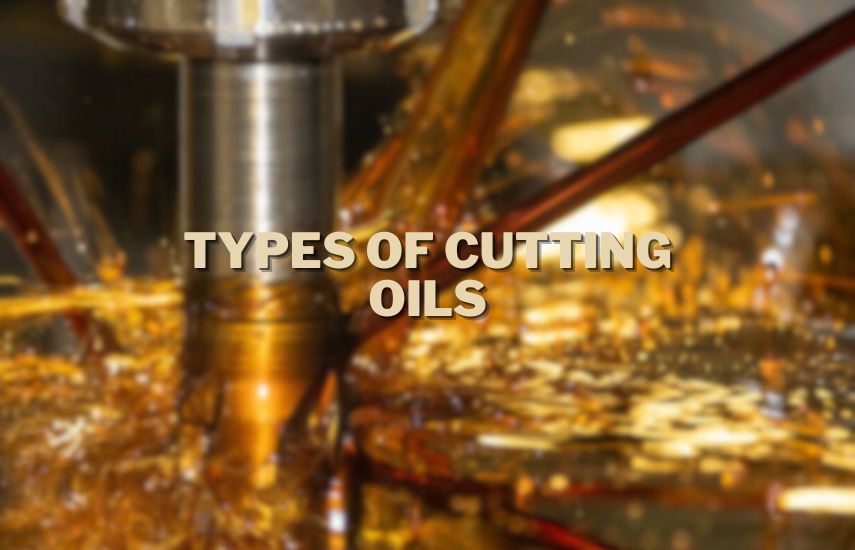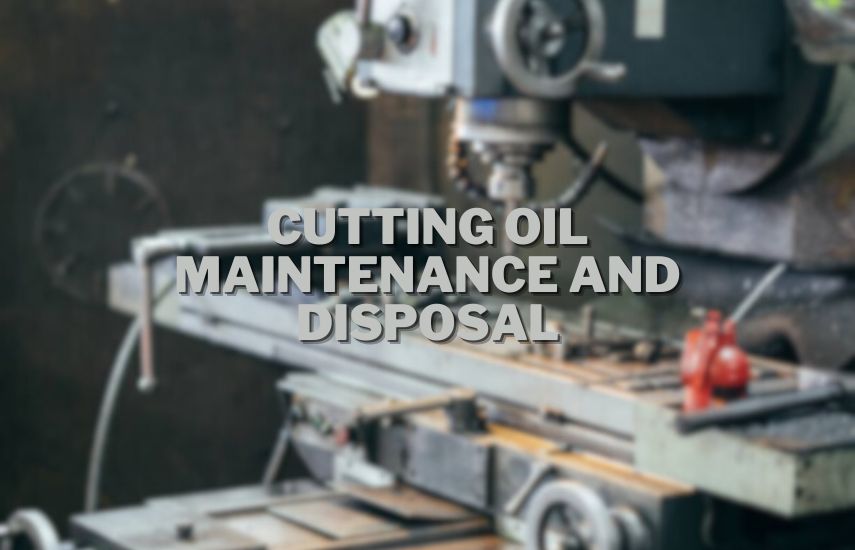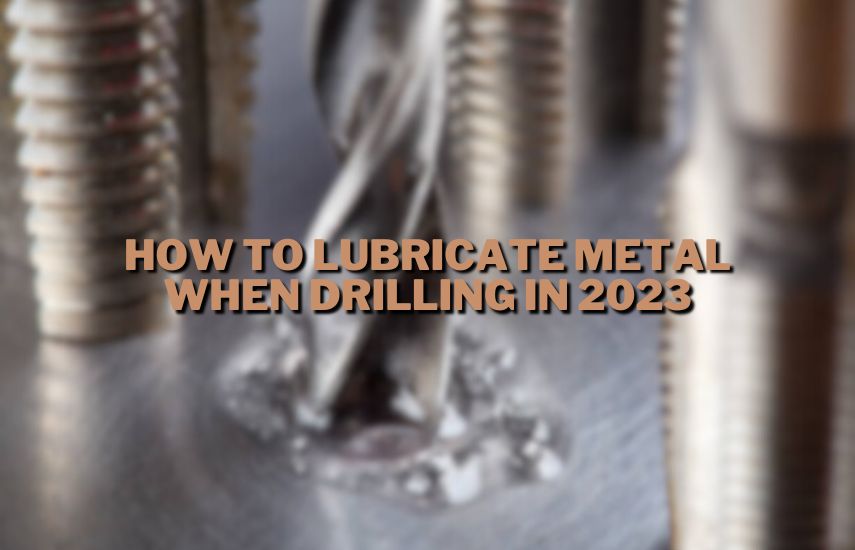If you’re a DIY enthusiast or a professional metalworker, you’ve probably encountered the challenge of drilling through tough metals.
The process can be time-consuming and exhausting, and if you’re not careful, you can easily damage your drill bit.
How to Lubricate Metal When Drilling? When drilling metal, it’s important to use cutting oil as a lubricant.
This helps to reduce friction and heat, which can cause the drill bit to wear out quickly. Cutting oil helps to flush away metal chips and debris, ensuring a cleaner and more precise cut.
That’s where cutting oil comes in. Cutting oil is a lubricant that reduces friction and heat generated during metal cutting, making the drilling process smoother and more efficient.
In this blog, we’ll explore the benefits of using cutting oil and how it can help you achieve better results in your metalworking projects.
The Science Behind Cutting Oils
Cutting oils are commonly used in metalworking operations to lubricate and cool the cutting tool and workpiece during drilling, milling, turning, and other machining processes. But what exactly is the science behind cutting oils?
The Role of Cutting Oils in Reducing Heat and Friction
During metalworking operations, heat and friction can cause excessive wear and damage to both the cutting tool and workpiece.
Cutting oils act as a lubricant to reduce the friction between the tool and workpiece, which helps to prevent overheating and premature wear.
By reducing friction, cutting oils also reduce the amount of energy required to perform the cutting operation, resulting in a more efficient process and improved tool life. Cutting oils also help to dissipate heat generated during the cutting process.
As the cutting tool moves through the workpiece, it generates heat due to friction and deformation of the metal.
Cutting oils absorb some of this heat and carry it away from the cutting zone, helping to prevent the tool and workpiece from overheating.
The Impact of Cutting Oil on Tool Life and Surface Finish
The use of cutting oils can have a significant impact on tool life and surface finish. By reducing friction and dissipating heat, cutting oils help to prevent excessive wear and damage to the cutting tool, resulting in a longer tool life.
In addition, cutting oils can also help to improve the surface finish of the workpiece by reducing the amount of heat generated during the cutting process, which can lead to less surface roughness and better dimensional accuracy.
It is important to note that the type of cutting oil used can also have an impact on tool life and surface finish.
Different cutting oils have different properties, such as viscosity, flash point, and lubricity, which can affect their performance in different metalworking applications.
Types of Cutting Oils

When it comes to drilling metal, using cutting oil to lubricate the process can make a significant difference in the results.
Cutting oil helps reduce friction and heat, which can increase the tool life and prevent the material from warping or cracking.
There are different types of cutting oils available in the market, each with its own set of advantages and disadvantages.
Straight oils
Straight oils, also known as neat oils, are pure mineral oils that are commonly used in machining operations. They provide excellent lubrication and cooling properties, making them ideal for heavy-duty operations that generate a lot of heat.
Straight oils are suitable for low to medium cutting speeds, and they work well with a variety of metals, including aluminum, copper, and brass. However, they are not recommended for use with ferrous metals, as they can cause staining and corrosion.
Soluble oils
Soluble oils, also known as emulsifiable oils, are a mixture of mineral oil and water. They are designed to form a stable emulsion when mixed with water, which makes them easy to apply and clean.
Soluble oils offer good lubrication and cooling properties, making them suitable for a wide range of cutting operations.
They are particularly effective at reducing heat and extending tool life. Soluble oils are compatible with most metals, including ferrous and non-ferrous materials.
Semi-synthetic cutting oils
Semi-synthetic cutting oils, as the name suggests, are a blend of mineral oil and synthetic oil. They offer a balance between the lubrication and cooling properties of straight oils and the emulsifiability of soluble oils.
Semi-synthetic cutting oils are suitable for a wide range of machining operations, from low-speed operations to high-speed cutting. They are also compatible with most metals and offer good corrosion protection.
Synthetic cutting oils
Synthetic cutting oils are made from synthetic esters, polyglycols, or other synthetic base stocks. They offer superior lubrication and cooling properties compared to other types of cutting oils, making them ideal for high-speed machining operations.
Synthetic cutting oils also offer excellent oxidation resistance and thermal stability, which means they can last longer than other types of cutting oils.
However, they are generally more expensive than other types of cutting oils and may not be suitable for all metals.
Choosing the Right Cutting Oil
Choosing the right cutting oil is essential to achieving efficient and effective metal drilling. Not all cutting oils are created equal, and it is important to consider a range of factors when making a decision.
Material Compatibility
One of the most important considerations when choosing a cutting oil is material compatibility. Different types of cutting oils are formulated for different materials, and using the wrong type of oil can lead to poor drilling results, damage to your equipment, or even safety hazards.
For example, when drilling aluminum or other non-ferrous metals, it is important to use a cutting oil that is specifically designed for those materials.
These oils are often low viscosity, which helps to prevent the material from gumming up the drill bit and causing damage.
On the other hand, drilling ferrous metals like steel or iron requires a cutting oil with higher viscosity and more robust anti-wear additives to withstand the heat and pressure generated during drilling.
Environmental Considerations
Another important factor to consider when selecting a cutting oil is environmental considerations. Cutting oils can have a significant impact on the environment, and it is important to choose oils that are safe for both your workers and the environment.
One important consideration is the biodegradability of the oil. Some cutting oils are made with biodegradable ingredients that break down easily in the environment, while others contain synthetic or petroleum-based ingredients that can persist in the environment for long periods of time.
Machine Compatibility
Finally, when choosing a cutting oil, it is important to consider the compatibility of the oil with your drilling equipment.
Different types of equipment may require different types of cutting oils, and using the wrong type of oil can lead to damage to your equipment or reduced efficiency.
For example, some cutting oils may contain ingredients that can damage rubber seals or hoses in your equipment, while others may not provide adequate lubrication for high-speed drilling applications.
Application Methods for Cutting Oils

Cutting oils are a crucial component when it comes to metalworking. They are used to lubricate and cool down the metal being drilled, ensuring that the cutting process is smooth and efficient.
One of the most critical factors in achieving the desired results is choosing the right application method.
Flood application
Flood application is one of the most widely used methods of applying cutting oil. It involves pouring the cutting oil over the workpiece, ensuring that it covers the entire area being drilled. The oil is then circulated using a pump to ensure even coverage.
This method is ideal for large workpieces or when drilling multiple parts simultaneously. The main advantage of flood application is that it provides consistent cooling and lubrication, resulting in faster and more efficient drilling.
Mist application
Mist application involves spraying a fine mist of cutting oil onto the workpiece. This method is commonly used when drilling smaller workpieces or when precision is essential.
The mist is created using a high-pressure pump, which atomizes the cutting oil, producing a fine mist that is directed onto the drill bit and workpiece.
The main advantage of mist application is that it provides precise and localized lubrication, ensuring that the cutting process is as accurate as possible.
Brush application
Brush application involves using a brush to apply cutting oil to the workpiece. This method is typically used when drilling irregularly shaped workpieces or when a high level of precision is required.
The brush is dipped in the cutting oil and then applied to the workpiece manually. The main advantage of brush application is that it allows for precise and targeted lubrication, ensuring that the cutting process is as accurate as possible.
Drip application
Drip application involves dripping cutting oil onto the workpiece at a controlled rate. This method is typically used when drilling small holes or when precision is essential.
The oil is dripped onto the drill bit and workpiece, providing targeted lubrication that is precisely controlled.
The main advantage of drip application is that it provides consistent lubrication and cooling, ensuring that the cutting process is efficient and accurate. Selecting the right application method for cutting oil is essential to ensure that the cutting process is efficient and accurate.
Flood, mist, brush, and drip application methods are all effective, and the choice of method will depend on the size and shape of the workpiece and the level of precision required.
Benefits of Using Cutting Oil When Drilling Metal
When it comes to drilling metal, using cutting oil to lubricate the process can make a significant difference in the outcome.
Cutting oil is a lubricant specifically designed for metalworking operations and is applied to the workpiece or the cutting tool to reduce friction and dissipate heat.
Improved cutting performance
Cutting oil can improve cutting performance by reducing the amount of heat generated during the drilling process. As the drill bit moves through the metal, friction generates heat that can cause the bit to dull prematurely.
Cutting oil helps to dissipate this heat, keeping the drill bit cool and sharp for longer periods of time. Cutting oil can help to remove chips and debris from the cutting area, preventing them from clogging the drill bit and slowing down the drilling process.
Extended tool life
By reducing the amount of heat generated during the drilling process, cutting oil can also help to extend the life of the cutting tool.
Excessive heat can cause the cutting tool to wear out more quickly, leading to the need for frequent replacements.
By keeping the tool cool, cutting oil can help to prevent premature wear and tear, saving time and money in the long run.
Enhanced surface finish
Cutting oil can also enhance the surface finish of the workpiece. When drilling metal without lubrication, the drill bit can create burrs and other imperfections on the surface of the metal.
Cutting oil helps to reduce the friction between the drill bit and the workpiece, resulting in a smoother and more even surface finish.
Reduced risk of workpiece damage
When drilling metal without lubrication, there is a risk of workpiece damage due to excessive heat and friction. The workpiece may become distorted, warped, or cracked, rendering it unusable.
Cutting oil helps to reduce the amount of heat generated during the drilling process, reducing the risk of damage to the workpiece.
Cutting oil can help to reduce the amount of force required to drill through the metal, further reducing the risk of damage.
Cutting Oil Maintenance and Disposal

Cutting oil is an essential lubricant that improves the performance and longevity of metal drilling tools. However, to ensure its effectiveness, it’s important to monitor and maintain the quality of the cutting oil used, as well as properly dispose of it to avoid environmental harm and comply with legal regulations.
Monitoring and maintaining cutting oil quality
Maintaining cutting oil quality is pivotal for effective machining. To ensure optimal performance, a holistic approach is vital. Regular monitoring of viscosity, pH levels, and contaminants aids in catching deviations from desired standards.
Proper storage away from extreme conditions prevents premature oil degradation. Applying filtration systems combats accumulated impurities. Balancing oil changes is essential to minimize waste and costs; condition-based changes prove sustainable.
Collaboration between operators and maintenance staff enhances communication and issue resolution.
This comprehensive strategy optimizes cutting oil lifespan, reduces downtime, and fosters consistent high-quality results, boosting overall manufacturing success.
Environmental and legal aspects of cutting oil disposal
Managing the disposal of cutting oil comes with environmental and legal responsibilities. We must consider both aspects to ensure a sustainable approach. Improper disposal can harm the environment, contaminating soil and water.
Laws and regulations are in place to prevent this. Disposing of cutting oil requires adherence to proper methods, such as recycling, reclamation, or authorized disposal facilities. Ignoring these guidelines can lead to legal consequences.
By respecting environmental concerns and legal obligations, we contribute to a healthier planet and comply with regulations, safeguarding our surroundings for present and future generations.
Best practices for cutting oil recycling
Embracing effective cutting oil recycling practices is key to sustainability. Let’s delve into some guiding principles for optimal recycling. Begin by segregating used cutting oil from other waste. Proper storage in labeled containers prevents contamination.
Before recycling, ensure the oil is free from excess debris and water. Partner with certified recycling centers or service providers to guarantee proper treatment. Regularly monitor oil quality and lifespan, avoiding overuse.
By adhering to these practices, we minimize environmental impact, conserve resources, and contribute to a greener future. Remember, small steps today pave the way for a cleaner tomorrow.
Conclusion
Lubricating metal while drilling is crucial for the longevity of your equipment. By applying cutting oil, the drill bit can easily cut through the metal without overheating or becoming dull.
Moreover, the oil will wash away any metal shavings, leaving you with a clean and accurate hole.
To sum up, cutting oil serves a crucial role in safeguarding drill bits against abrasion-induced wear. When drilling metal exclusively, opt for a cutting oil specifically tailored for metal applications.
Since various oils excel with distinct metal types, it’s essential to align your requirements precisely with the appropriate oil variant.
We have explored the various benefits of using cutting oil in metal drilling operations, including how it helps to cool the metal, reduces tool wear, and improves overall productivity.
We have also discussed the different types of cutting oils available and the factors to consider when selecting the right cutting oil for your specific needs.
Frequently Asked Questions
What can I use as lubricant when drilling metal?
When drilling metal, using an appropriate lubricant is essential to enhance the drilling process and prolong the life of your tools.
Common options for lubricants include cutting oils, tapping fluids, or even vegetable oil. Cutting oils are specifically formulated to reduce friction and heat, making them ideal for metal drilling.
Tapping fluids offer similar benefits and are suitable for threading operations. Even vegetable oil can serve as a makeshift lubricant, although its effectiveness might be limited compared to purpose-made products.
Choose a lubricant based on the type of metal and the drilling operation you’re performing for the best results.
Should I use lubricant when drilling metal?
Yes, using a lubricant when drilling metal is highly recommended. Lubricants play a crucial role in reducing friction and heat generated during the drilling process. This helps prevent your drill bit from overheating, wearing out quickly, or even breaking.
Lubricants also facilitate smoother chip evacuation and improve the overall cutting efficiency. Whether you’re drilling holes in stainless steel, aluminum, or other metals, applying an appropriate lubricant will significantly improve your drilling experience and the quality of the holes you create.
Can I use WD-40 when drilling metal?
While WD-40 is a versatile product, it might not be the best choice as a lubricant for drilling metal. WD-40 is more of a water-displacing and rust-prevention spray, rather than a specialized cutting oil or lubricant.
It might offer some temporary benefits, such as reducing friction, but it isn’t specifically formulated for metal drilling.
For optimal results, it’s better to use a dedicated cutting oil or lubricant that is designed to withstand the high temperatures and pressures generated during metal drilling.
What oil is used for drilling?
The oil used for drilling is commonly referred to as “cutting oil” or “cutting fluid.” Cutting oil is formulated to reduce friction, dissipate heat, and prolong the life of cutting tools during machining operations like drilling.
Different types of cutting oil are available, each tailored to specific materials and machining processes. For drilling metal, using a cutting oil designed for metalworking is recommended.
These oils are often enriched with additives to provide better lubrication and cooling, enhancing the overall drilling efficiency and the quality of the finished holes.









